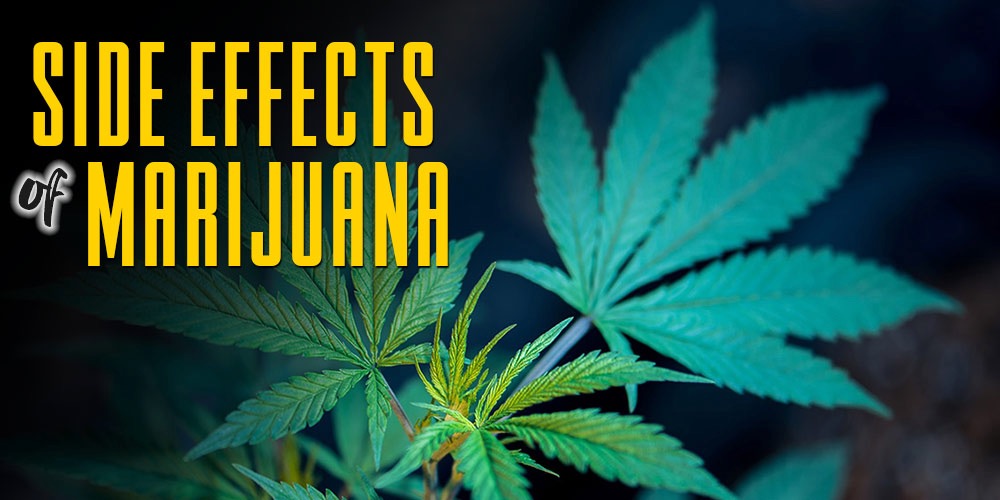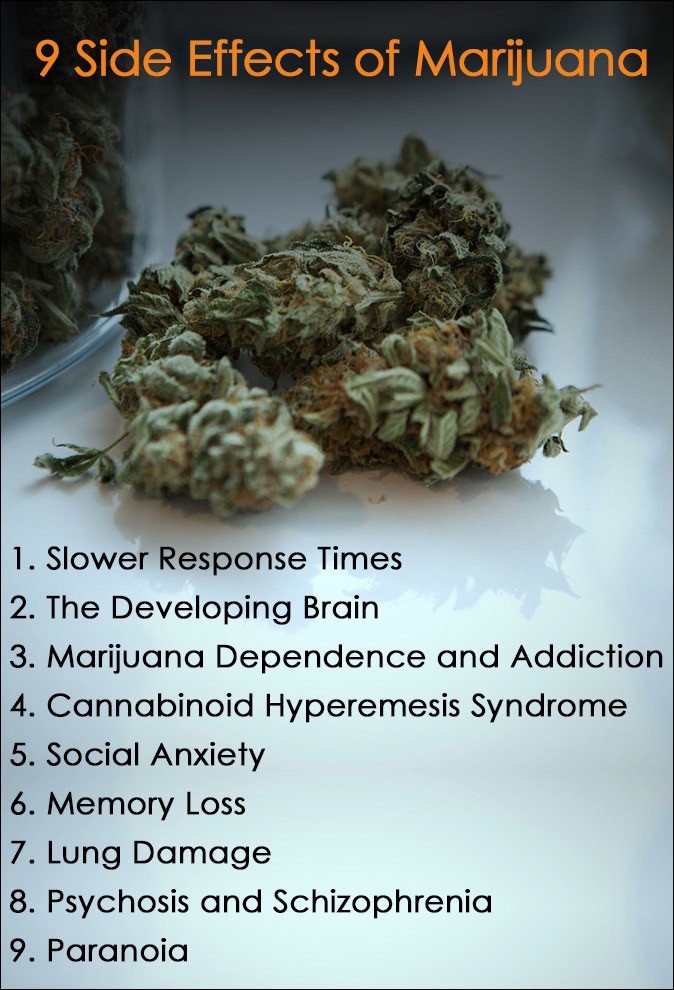
Understanding the side effects of marijuana is more important now than ever since its use is on the rise as laws surrounding weed are being relaxed throughout the United States.
Many states, such as Alaska, California, Washington and Nevada now allow adults over the age of 21 to use Marijuana for recreational purposes.
Other states such as North Dakota, New Jersey and Montana allow marijuana use for medicinal purposes such as migraines, epilepsy or anxiety. Marijuana is decriminalized in many other states meaning that people won’t get put in jail if they are found with weed.
However, states like Idaho, Indiana, Kentucky and Tennessee still classify marijuana as illegal.
Whether it’s legal or not, users should still be aware of the negative side effects of marijuana use.
The Effects of Marijuana Legalization
With over 62% of U.S. citizens in favor of cannabis legalization – the general trend is toward decriminalization or legalization throughout the US.
The government is benefiting from millions in additional revenue from taxing marijuana. Medical marijuana already brings in several billions of dollars in revenue without adding tax revenue from recreational cannabis.
State taxation from cannabis has risen 57% from 2017 to 2018 and the legal cannabis market is expected to grow to $25 billion by 2025. Cannabis taxation revenue is growing rapidly in line with a growing number of people smoking weed.
It pays to know about the effects of marijuana, both positive and negative. While marijuana use is generally regarded as safe, the negative effects must be assessed to ensure it’s used wisely.
Here we’ll explore some of the side effects of weed, more specifically, how delta-9-tetrahydrocannabinol (THC) – the main psychoactive component of marijuana works in the body, and what to watch out for.

9 Side Effects of Marijuana
1. Slower Response Times
Despite the DSM-V criterion for marijuana intoxication requiring impairment of complex cognitive functioning, that’s not been found to be the case in many clinical trials. In fact, heavy, daily, marijuana smokers display slower cognitive performance – not impairment – meaning it took the marijuana users longer to respond to a stimulus.
Being slow to respond can be detrimental when using machinery. For this reason it is illegal to drive under the influence of alcohol, marijuana, opioids, methamphetamines, or any potentially impairing drug.
It’s well known that alcohol and marijuana slow coordination, judgment, and reaction times.
Additionally THC hinders the ability to multitask, which is a critical skill for safe driving. Although using marijuana is legal in some states, it’s always illegal to drive under the influence.
2. The Developing Brain and Long Term Side Effects of Marijuana
A study carried out on animal models found that taking what is considered a “moderate dose” of delta-9-tetrahydrocannabinol (THC) during pregnancy impaired the brains of the offspring. The study showed that cannabis consumption during pregnancy can lead to irreversible and subtle dysfunctions in the brain.
Similar effects were found in adolescent animals where their spatial working memory was affected, especially when cannabis was used while the delicate neural circuits in the brain were developing.
These and other studies have concluded that many long-term side effects of marijuana are due to smoking weed during the developmental stages (prenatal through to the age of 21).
To assess the full effects of substances on the developing brain, a large study of over 10,000 children is now being carried out called the “Adolescent Brain Cognitive Development (ABCD Study).”
3. The Effects of Marijuana Dependence and Addiction
Even with medical intervention, the effects of marijuana use can be difficult for heavy users who have developed a dependence or addiction to smoking weed.
Smoking five marijuana cigarettes per day (3 to 4 times per week) can cause withdrawal symptoms such as decreased food intake, increased stomach upset, anxiety, irritability, depression, nervousness, cravings and difficulty sleeping.
These symptoms can be suppressed by smoking or consuming THC, making weed just as hard to quit as other drugs.
Symptoms of cannabis withdrawal typically emerge after 1 to 2 days of abstinence.
Thankfully, symptoms can be managed with medication, and largely resolve within 10 days.
4. Cannabinoid Hyperemesis Syndrome
No matter what form of cannabis is consumed (vape, edibles or smoking) there’s always the risk of suffering from Cannabinoid Hyperemesis Syndrome (CHS) if usage becomes persistent.
The symptoms of Cannabinoid Hyperemesis Syndrome include:
- Nausea
- Vomiting
- Dehydration
- Abdominal cramping
CHS is a rare condition and usually only happens to daily long-term marijuana users, such as people who have smoked marijuana every day for several years.
THC doesn’t only affect the brain, it also creates changes in the digestive tract and stomach (as many frequent weed users will be well aware of when they get the “munchies”).
CHS can be treated by stopping the use of marijuana and symptoms should subside within days or months.
Once marijuana use has stopped, there are several short term medical interventions that may help such as IV fluids, pain medication and PPI’s.
If someone is suffering from Cannabinoid Hyperemesis Syndrome, they should get help after persistent vomiting for a day or more.
5. Social Anxiety
Socially anxious individuals are considered a high-risk group and not advised to use cannabis. People suffering from social anxiety disorder (SAD) normally report symptoms starting as a teenager.
There are conflicting views on whether or not social anxiety is caused by on-going marijuana use.
However, it is certain that psychiatric disorders increase the risk for developing substance use addiction.
Although many people report that cannabis use is good for soothing their anxiety or internalizing disorders, it is clear that many report suffering from these illnesses after cannabis dependence.
Every person reacts in unique ways to cannabis depending on various factors such as length of use, age, genes and environment.
The anxiety-producing component of cannabis is THC and the anti-anxiety component is Cannabidiol (CBD).
One study showed that 90% of those with cannabis dependence also had a lifetime mental disorder.

6. Memory Loss
Regular marijuana use is known to increase the risk for developing mental health conditions.
In addition to this, animal models have shown “significant memory impairments” when exposed to the drug long-term.
The negative effects on memory were captured with brain scans, which exposed that the regions involved in memory and learning were affected.
Researchers note that while marijuana may have beneficial effects on some, such as those suffering from epilepsy or multiple sclerosis, like other drugs, it can be dangerous if misused.
On-going exposure to THC has been shown to result in memory deficits.
7. Lung Damage Effects of Marijuana Use
The American Lung Association (ALA) has stated that they are concerned with the health impacts of smoking marijuana. Any form of consuming marijuana using heat or vapor (pipes, bongs, paper-wrapped joints or blunts) can have detrimental effects on the lungs.
The act of smoking damages the airways and can cause injury to tissues.
Marijuana smoke contains carcinogens that have not been proven yet to cause cancer with light to moderate cannabis use. While not as damaging to the lungs as tobacco, smoking weed can lead to chronic bronchitis and lung infections.
8. Psychosis and Schizophrenia
Marijuana is one of the most abused substances by people with schizophrenia. Scientists have found that specific genes are more susceptible to psychosis and that schizophrenia symptoms can be brought on by early cannabis use.
The THC component of cannabis is thought to trigger psychosis in some individuals, while another component – Cannabidiol (CBD) has been shown to fight it.
People who have a family history of psychosis or schizophrenia are advised to avoid marijuana. The chemical changes in the brain brought about by cannabis use can double the risk of developing mental illness.
Furthermore, some researchers state that a percentage of people with schizophrenia would not have developed the conditions if it had not been triggered by marijuana use.
9. Paranoia
Paranoia is an unfounded or excessive fear that someone is trying to harm us. Some people are more susceptible to paranoid thoughts than others.
One study in England found that the belief that someone was trying to harm them was three times more likely in those using marijuana. Again on-going use of marijuana can cause many of the negative effects of weed.
People can also develop paranoid thoughts without hearing voices or hallucinations.
Another study carried out by the Guardian found that THC caused paranoid thoughts in half of their participants compared to 30% in the placebo group.
How To Stop Getting High – Treatment for Marijuana Addiction and Dependence
We’ve outlined some of the most common side effects of marijuana, but we didn’t touch on the dangers of synthetic marijuana, which is a completely different topic altogether.
Medical and recreational marijuana is now legal in over half the states in the U.S., yet it remains a Schedule I drug according to the DEA. Because of this, very few studies have been done thus far about the positive or negative effects of using it. Hopefully that research will be coming soon.
Even though it is legal in so many states, it’s important for people to use it responsibly and in moderation, just like alcohol.
Like any substance of misuse, there is a very real possibility of dependence and addiction, as well as withdrawal.
For anyone concerned that their cannabis use is becoming a problem, or they have experienced any of the negative side effects of marijuana, know that addiction treatment is available and recovery is possible.
For those with a mental health issue combined with addiction, it’s necessary to explore dual diagnosis treatment options so that both issues can be addressed at the same time.
Related Posts
- Oxycodone Side Effects and Dependence or Addiction
What is Oxycodone? Oxycodone is an opioid drug, commonly known under the brand names Oxycontin…
- Long Term Side Effects of Drugs and Addiction
There's a lengthy list of long-term side effects of drugs and addiction that affect both…
- Gabapentin High, Side Effects and Dangerous Misuse
There’s no hiding from it, the opioid crisis is making headlines the world over. At…
